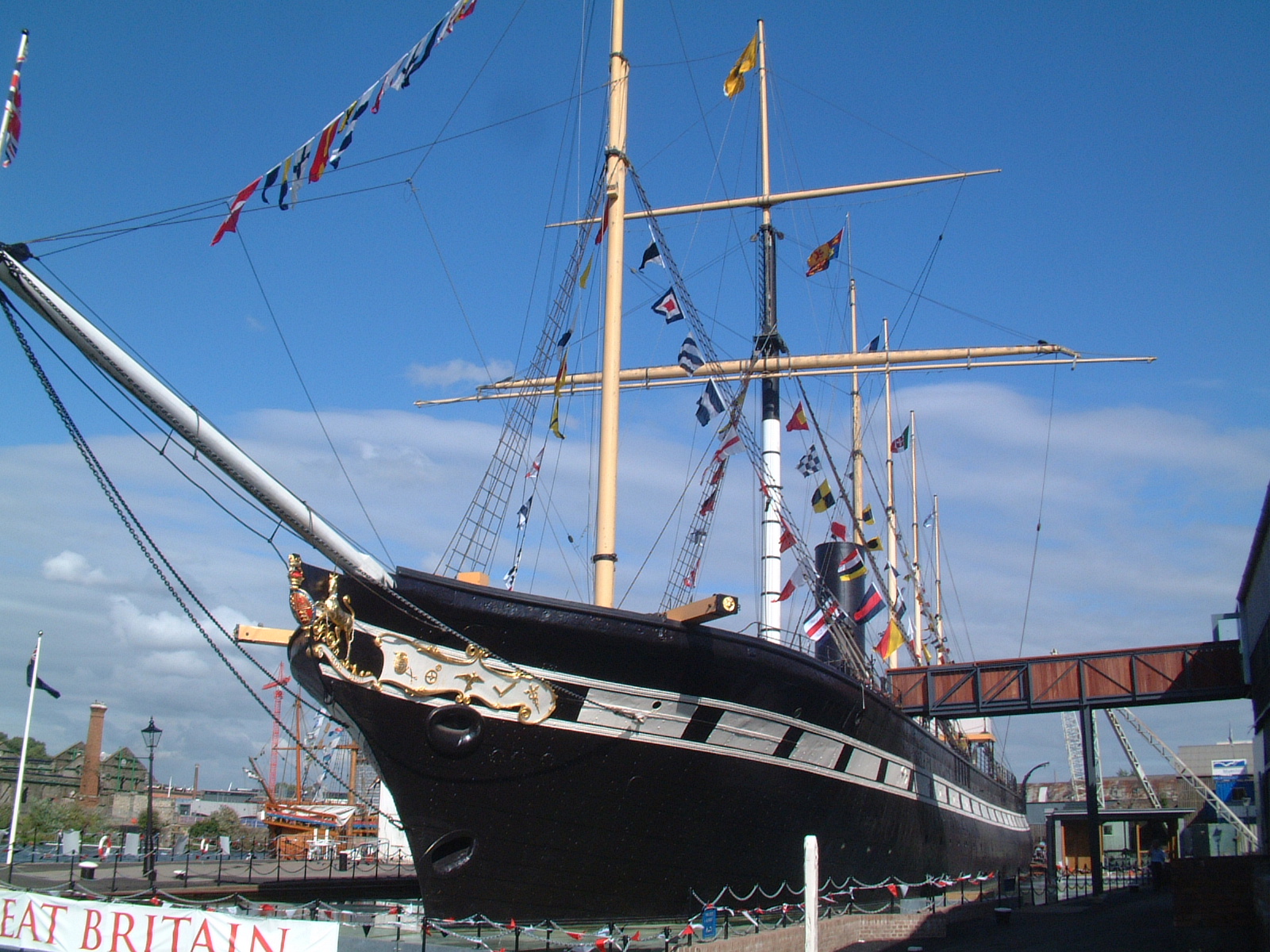SS Great Britain
SS Great Britain is a museum ship and former passenger steamship, which was advanced for her time. She was the longest passenger ship in the world from 1845 to 1854. She was designed by Isambard Kingdom Brunel for the Great Western Steamship Company's transatlantic service between Bristol and New York. While other ships had been built of iron or equipped with a screw propeller, Great Britain was the first to combine these features in a large ocean-going ship. She was the first iron steamer to cross the Atlantic, which she did in 1845, in the time of 14 days.
The ship is 322 ft (98 m) in length and has a 3,400-ton displacement. She was powered by two inclined 2 cylinder engines of the direct-acting type, with twin 88 in (220 cm) bore, 6-foot (1.8 m) stroke cylinders. She was also provided with secondary sail power. The four decks provided accommodation for a crew of 120, plus 360 passengers who were provided with cabins, dining, and promenade saloons.
When launched in 1843, Great Britain was by far the largest vessel afloat. However, her protracted construction and high cost had left her owners in a difficult financial position, and they were forced out of business in 1846 having spent all their funds re-floating the ship after she was run aground at Dundrum Bay after a navigational error. In 1852 she was sold for salvage and repaired. Great Britain carried thousands of immigrants to Australia from 1852 until converted to sail in 1881. Three years later, she was retired to the Falkland Islands where she was used as a warehouse, quarantine ship and coal hulk until scuttled in 1937.
In 1970, following a cash donation by Sir Jack Hayward that paid for the vessel to be towed back to the UK, Great Britain was returned to the Bristol dry dock where she was built. Now listed as part of the National Historic Fleet, she is an award-winning visitor attraction and museum ship in Bristol Harbour, with between 150,000 and 200,000 visitors annually.
The salvage operation, was organised by 'the SS Great Britain Project', chaired by Richard Goold-Adams. Ewan Corlett conducted a naval architect's survey, reporting that she could be refloated. A submersible pontoon, Mulus III, was chartered in February 1970. A German tug, Varius II, was chartered, reaching Port Stanley on 25 March. By 13 April, after some concern about a crack in the hull, the ship was mounted successfully on the pontoon and the following day the tug, pontoon and the Great Britain sailed to Port Stanley for preparations for the transatlantic voyage. The voyage (code name "Voyage 47") began on 24 April, stopped in Montevideo from 2 May to 6 May for inspection, then across the Atlantic, arriving at Barry Docks, west of Cardiff on 22 June. ("Voyage 47" was chosen as the code name because it was on her 47th voyage from Penarth, in 1886, that during a tempest she had sought shelter in the Falklands.) Bristol-based tugs then took over and towed her, still on her pontoon, to Avonmouth Docks.
The ship was then taken off the pontoon, in preparation for her re-entry into Bristol, now truly afloat. On Sunday 5 July, amidst considerable media interest, the ship was towed up the River Avon to Bristol. Perhaps the most memorable moment for the crowds that lined the final few miles was her passage under the Clifton Suspension Bridge, another Brunel design. She waited for two weeks in the Cumberland Basin for a tide high enough to get her back through the locks to the Floating Harbour and her birthplace, the dry dock in the Great Western Dockyard (now a grade II* listed building, disused since bomb damage in the Second World War).
The original intent was to restore her to her 1843 state. However, the philosophy changed and the conservation of all surviving pre-1970 material became the aim. In 1984 the SS Great Britain was designated as a Historic Mechanical Engineering Landmark by the American Society of Mechanical Engineers, the fourth such designation outside the USA.
By 1998, an extensive survey discovered that the hull was continuing to corrode in the humid atmosphere of the dock and estimates gave her 25 years before she corroded away.Extensive conservation work began which culminated in the installation of a glass plate across the dry dock at the level of her water line, with two dehumidifiers, keeping the space beneath at 20% relative humidity, sufficiently dry to preserve the surviving material. This being completed, the ship was "re-launched" in July 2005, and visitor access to the dry dock was restored. The site is visited by over 150,000 visitors per year with a peak in numbers in 2006 when 200,000 people visited.


